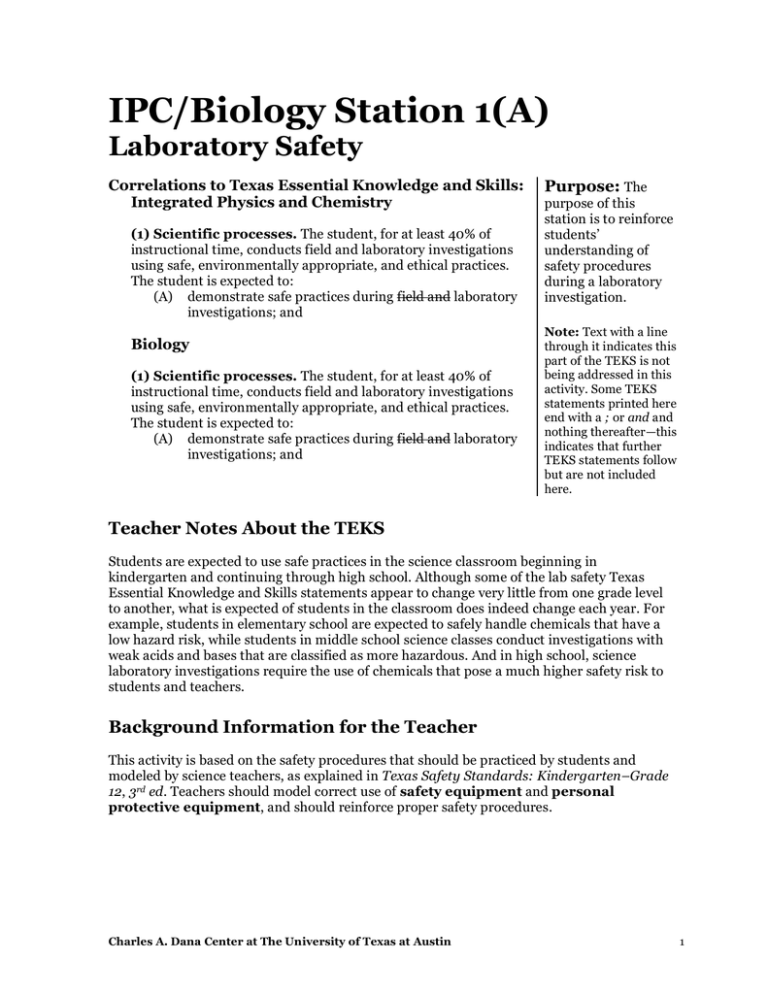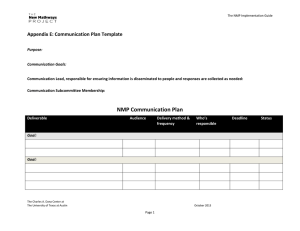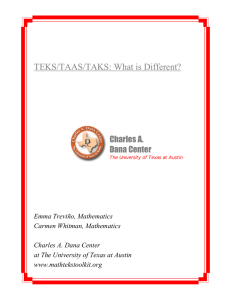IPC/Biology Station 1(A) Laboratory Safety Purpose:
advertisement

IPC/Biology Station 1(A) Laboratory Safety Correlations to Texas Essential Knowledge and Skills: Integrated Physics and Chemistry (1) Scientific processes. The student, for at least 40% of instructional time, conducts field and laboratory investigations using safe, environmentally appropriate, and ethical practices. The student is expected to: (A) demonstrate safe practices during field and laboratory investigations; and Biology (1) Scientific processes. The student, for at least 40% of instructional time, conducts field and laboratory investigations using safe, environmentally appropriate, and ethical practices. The student is expected to: (A) demonstrate safe practices during field and laboratory investigations; and Purpose: The purpose of this station is to reinforce students’ understanding of safety procedures during a laboratory investigation. Note: Text with a line through it indicates this part of the TEKS is not being addressed in this activity. Some TEKS statements printed here end with a ; or and and nothing thereafter—this indicates that further TEKS statements follow but are not included here. Teacher Notes About the TEKS Students are expected to use safe practices in the science classroom beginning in kindergarten and continuing through high school. Although some of the lab safety Texas Essential Knowledge and Skills statements appear to change very little from one grade level to another, what is expected of students in the classroom does indeed change each year. For example, students in elementary school are expected to safely handle chemicals that have a low hazard risk, while students in middle school science classes conduct investigations with weak acids and bases that are classified as more hazardous. And in high school, science laboratory investigations require the use of chemicals that pose a much higher safety risk to students and teachers. Background Information for the Teacher This activity is based on the safety procedures that should be practiced by students and modeled by science teachers, as explained in Texas Safety Standards: Kindergarten–Grade 12, 3rd ed. Teachers should model correct use of safety equipment and personal protective equipment, and should reinforce proper safety procedures. Charles A. Dana Center at The University of Texas at Austin 1 Essential Science Concepts for Exit-Level TAKS IPC/Biology Station 1(A) Laboratory Safety Resources Collins, J. W. (2006). Texas Safety Standards: Kindergarten–Grade 12 (3rd ed.). Austin, TX: Charles A. Dana Center at The University of Texas at Austin. “Safety and facilities.” Science TEKS Toolkit. Charles A. Dana Center at The University of Texas at Austin. www.utdanacenter.org/sciencetoolkit/safety/. (Date retrieved: April 27, 2007.) Materials Safety goggles (1) Safety glasses (1) Laboratory apron (1) Protective gloves (1 pair) Methanol chemical label (included in the blackline masters for this station) Material Safety Data Sheet (MSDS) for hydrochloric acid (included in the blackline masters for this station) TAKS Formulas chart (included in the blackline masters for this station) Station information sheet (included in blackline masters for this station) Student pages, including glossary (included in blackline masters for this station) Question card (see Advance Preparation) Advance Preparation 1. Print, laminate, and cut out the hydrochloric acid MSDS and methanol chemical label. 2. For each student, copy the student pages (including glossary), station information sheet, and TAKS Formulas chart; for the station table, make a copy of the station information sheet and TAKS Formulas chart. 3. Make a question card using question 24 from the Released TAKS Test for Exit Level Science, July 2004. This released test can be found at www.tea.state.tx.us/ student.assessment/resources/release/taks. Station Setup 1. Place safety goggles, safety glasses, laboratory apron, pair of protective gloves, hydrochloric acid MSDS, and methanol chemical label on the table. 2. Tape a copy of the station information sheet to the table. Students will use this to confirm the station is set up correctly. Procedures 1. When students arrive at the station, they should check the station setup against the station information sheet at the table. If anything is missing or out of place, the students should notify the teacher. 2. Students should read the procedures in the student pages and answer the questions. Charles A. Dana Center at The University of Texas at Austin 2 Essential Science Concepts for Exit-Level TAKS IPC/Biology Station 1(A) Laboratory Safety Guide to Student Responses Focus Question: A student who is not wearing safety goggles during a laboratory investigation gets some chemical in his eyes. What proper lab procedures should he follow to remove the chemical from his eyes? He should go immediately to the eye/face wash station and activate the water flow by pushing the handle away from him. He needs to lean over and, while holding both eyelids open, lower his face into the water flow so that both eyes are being flushed simultaneously. He should continue rinsing his eyes for at least 15 minutes. Scenario While working in the laboratory, student A is carrying an open container of acid and accidentally splashes some of the acid on the front of student B’s shirt. Student C, seated nearby, stands up and bumps into student A. Acid splashes onto student C, and now the acid is burning part of his left hand. 1. Which of the personal protective equipment at this station should the student wear during an investigation when hazardous chemicals are used? Explain how the personal protective equipment could have protected students B and C in this scenario. Safety goggles to protect the eyes from the chemicals, laboratory aprons to protect the front of the body, protective gloves to protect the hands from the chemical. All students working with or around hazardous chemicals should wear protective equipment. If students B and C had been wearing aprons and gloves, their skin probably wouldn’t have been exposed to and burned by the chemical. 2. Which of the following procedures should student C follow when splashed by the acid? (B) Run to the emergency safety shower, activate the water, and rinse the area splashed with acid for 15 minutes. 3. Which of the safety items at this station provides the most information about hydrochloric acid? The Material Safety Data Sheet (MSDS) for hydrochloric acid 4. Examine the safety goggles and safety glasses at the station. Explain which one protects your eyes the best and why you would want to have these on if a harmful chemical splashed onto your face. Safety goggles are better because they form a protective seal around the eyes. The complete protection offered by goggles would be especially important if a harmful chemical splashed onto your face. 5. A student at your laboratory table is using a Bunsen burner to heat a beaker of water. Would it be safe for the other laboratory team at your table to use methanol at the same time? Use the chemical label for methanol to support your answer. Three places on the chemical label for methanol warn not to use methanol around an open flame: (1) FLAMMABLE is printed on the right side of the red banner at the top of Charles A. Dana Center at The University of Texas at Austin 3 Essential Science Concepts for Exit-Level TAKS IPC/Biology Station 1(A) Laboratory Safety the label; (2) a FLAMMABLE warning is also printed in the heading on the left, under the red banner; and (3) the HAZARD RATING box lists a “serious” flammability rating of 3. 6. Which of the following procedures should you follow when another student is injured during a fire in the laboratory room? (C) Yell loudly to alert the teacher and listen for the teacher’s directions. Charles A. Dana Center at The University of Texas at Austin 4 Essential Science Concepts for Exit-Level TAKS IPC/Biology Station 1(A) Laboratory Safety Blackline Masters for IPC/Biology Station 1(A): Laboratory Safety Contents: MSDS for hydrochloric acid (1 copy for the station table) Chemical label for methanol (1 copy for the station table) TAKS Formulas chart (1 copy for station table and 1 for each student) Station information sheet (1 copy for station table and 1 for each student) Student pages (1 copy for each student) Glossary (1 copy for each student) Charles A. Dana Center at The University of Texas at Austin 5 Essential Science Concepts for Exit-Level TAKS IPC/Biology Station 1(A) Laboratory Safety Station Information Sheet IPC/Biology Station 1(A) Laboratory Safety Charles A. Dana Center at The University of Texas at Austin 6 Essential Science Concepts for Exit-Level TAKS Charles A. Dana Center at The University of Texas at Austin IPC/Biology Station 1(A) Laboratory Safety 7 IPC/Biology Station 1(A) Laboratory Safety Student Pages Before You Begin Check to see that all the items are present and organized according to the station information sheet. If you notice a problem, notify the teacher immediately. Materials Safety goggles Safety glasses Laboratory apron Protective gloves Methanol chemical label Material Safety Data Sheet (MSDS) for hydrochloric acid Glossary Focus Question: A student who is not wearing safety goggles during a laboratory investigation gets some chemical in his eyes. What proper lab procedures should he follow to remove the chemical from his eyes? Procedures 1. Discuss the focus question with your teammate(s) and record your answer. Charles A. Dana Center at The University of Texas at Austin Student Page 1 Essential Science Concepts for Exit-Level TAKS 2. IPC/Biology Station 1(A) Laboratory Safety Use the following scenario to answer questions 1–3 about safety procedures. Then answer questions 4–6 using your knowledge of lab safety procedures. Scenario While working in the laboratory, student A is carrying an open container of acid and accidentally splashes some of the acid on the front of student B’s shirt. Student C, seated nearby, stands up and bumps into student A. Acid splashes onto student C, and now the acid is burning part of his left hand. Questions 1. Which of the personal protective equipment at this station should the student wear during an investigation when hazardous chemicals are used? Explain how the personal protective equipment could have protected students B and C in this scenario. 2. Which of the following procedures should student C follow when splashed by the acid? (A) Go immediately to the teacher and explain what happened and who caused the accident. (B) Run to the emergency safety shower, activate the water, and rinse the area splashed with acid for 15 minutes. (C) Yell loudly and wait until the teacher comes to you and tells you what to do next. (D) Quickly wipe off the acid from your hand and forearm with a paper towel and dispose of the towel in the wastebasket. Charles A. Dana Center at The University of Texas at Austin Student Page 2 Essential Science Concepts for Exit-Level TAKS IPC/Biology Station 1(A) Laboratory Safety 3. Which of the safety items at this station provides the most information about hydrochloric acid? 4. Examine the safety goggles and safety glasses at the station. Explain which one protects your eyes the best and why you would want to have these on if a harmful chemical splashed onto your face. 5. A student at your laboratory table is using a Bunsen burner to heat a beaker of water. Would it be safe for the other laboratory team at your table to use methanol at the same time? Use the chemical label for methanol to support your answer. Charles A. Dana Center at The University of Texas at Austin Student Page 3 Essential Science Concepts for Exit-Level TAKS 6. IPC/Biology Station 1(A) Laboratory Safety Which of the following procedures should you follow when another student is injured during a fire in the laboratory room? (A) Try to put out the fire with water or smother the flames with an emergency fire blanket. (B) Run to the principal’s office and report that there is a fire in the science room. (C) Yell loudly to alert the teacher and listen for the teacher’s directions. (D) Sit quietly at your workstation until the fire has been put out. NOTE: Because other students are going to do the activity after you, be sure to put all the materials at the station back as you found them. Sometimes there will be materials that need to be renewed or replaced. If you need assistance or have any questions, ask your teacher. Charles A. Dana Center at The University of Texas at Austin Student Page 4 Essential Science Concepts for Exit-Level TAKS IPC/Biology Station 1(A) Laboratory Safety Question Card 1. Obtain the question card from your instructor. 2. Read the question and discuss the answer with your teammate(s). 3. Record the team’s consensus in your study folder and justify your answer. 4. Record the team’s answer on the instructor’s diagnostic wall chart. I Need to Remember Complete this part AFTER the class discussion of the station. I need to remember . . . Charles A. Dana Center at The University of Texas at Austin Student Page 5 Essential Science Concepts for Exit-Level TAKS IPC/Biology Station 1(A) Laboratory Safety Glossary for IPC/Biology Station 1(A) Personal protective equipment Personal protective equipment includes any type of safety equipment that is worn by a person to protect him or her from injury or to reduce the extent of injury in case of an accident. Examples of personal protective equipment include safety goggles, laboratory aprons, and protective gloves. Safety equipment Safety equipment is usually found in a science laboratory and can be used to protect people from injury or reduce the extent of injury in case of an accident. Examples of safety equipment include emergency safety showers, eye/face wash stations, and fire extinguishers. Charles A. Dana Center at The University of Texas at Austin Student Page 6 Essential Science Concepts for Exit-Level TAKS Charles A. Dana Center at The University of Texas at Austin IPC/Biology Station 1(A) Laboratory Safety Student Page 7 Essential Science Concepts for Exit-Level TAKS Charles A. Dana Center at The University of Texas at Austin IPC/Biology Station 1(A) Laboratory Safety Student Page 8 Essential Science Concepts for Exit-Level TAKS Charles A. Dana Center at The University of Texas at Austin IPC/Biology Station 1(A) Laboratory Safety Student Page 9


